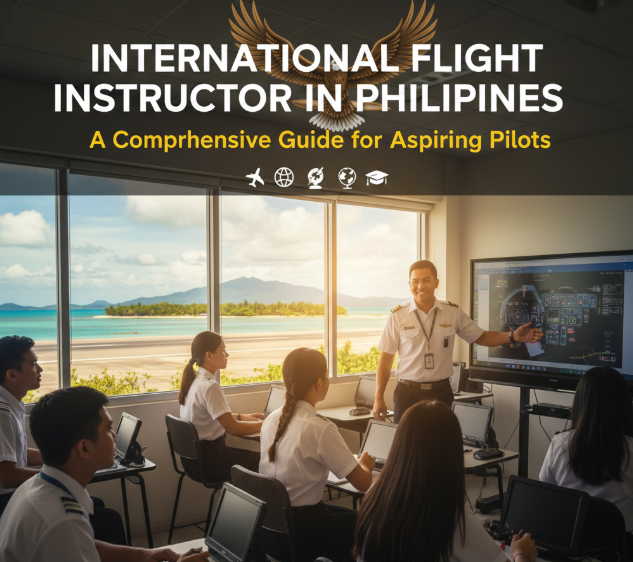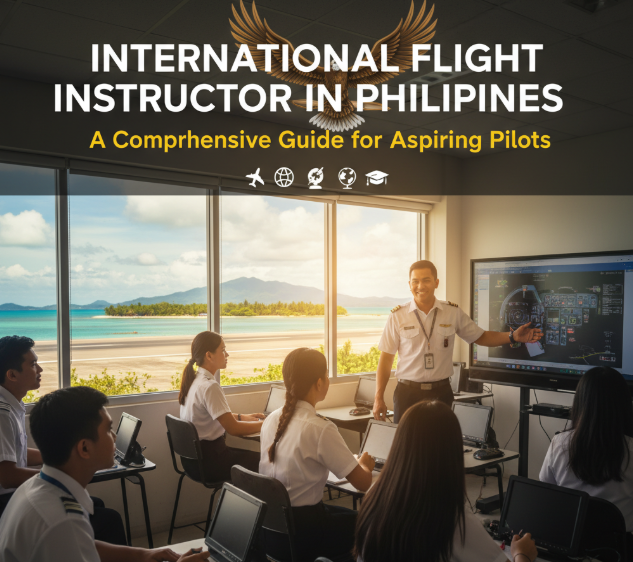
Aviation is a booming industry in the Philippines, with the country serving as a strategic hub in Southeast Asia for international flights. As the demand for skilled pilots and flight instructors increases, aspiring aviators have more opportunities than ever before to pursue careers in aviation. One of the most critical roles in the flight training ecosystem is the International Flight Instructor. This blog post will explore everything aspiring pilots need to know about becoming a flight instructor in the Philippines, the aviation landscape, and the future of aviation in the country.
Introduction to International Flight Instructor in Philippines
An international flight instructor in the Philippines plays a crucial role in shaping the next generation of pilots. These individuals are highly trained professionals responsible for teaching students the necessary skills to operate aircraft safely and effectively, both domestically and internationally. Whether you’re dreaming of becoming an airline pilot or a flight instructor yourself, understanding the requirements, training, and opportunities available is essential.
Flight instructors in the Philippines guide students through both theoretical and practical components of their aviation education. They work in collaboration with aviation academies, flight schools, and other institutions to ensure that the flight training meets international standards, allowing students to be eligible for global certifications and employment opportunities.
What Does the Role of a Flight Instructor Entail?
As an international flight instructor, your responsibilities extend beyond just teaching students how to fly. You will also mentor them, ensuring they understand aviation regulations, safety protocols, weather conditions, and other critical elements that affect flight operations. Your students may range from beginners who have never flown before to those looking to gain additional certifications or qualifications.
Importance of Aviation in the Philippines
Aviation has always been a vital component of the Philippines’ economy and infrastructure. The archipelago, consisting of over 7,000 islands, relies heavily on air transport for both domestic and international travel. This reliance on aviation makes pilot training, especially for international pilots, a crucial area of development.
The Philippines has an established reputation in the global aviation industry, with its airlines and pilots being in demand worldwide. The country’s role as a key international transit point for flights traveling between Asia, Europe, and the Americas also increases the demand for skilled aviators, including flight instructors who can help train these pilots.
Early Aviation History of the Philippines
Aviation in the Philippines dates back to the early 20th century, with the first recorded flight in 1910. However, the country’s aviation industry began to take shape with the establishment of the Philippine Airlines (PAL) in 1941. Over the decades, the aviation sector has grown exponentially, with international flight schools emerging to meet the demand for pilots.
The development of the aviation industry has been complemented by the creation of air traffic control systems, airport infrastructure, and global airline partnerships. The rise of international flight schools and training programs in the Philippines has made it one of the leading countries in Asia for pilot training.
Current Role of International Flight Instructors in the Philippines
Flight instructors in the Philippines now play a pivotal role in maintaining the standard of aviation education in the country. These instructors ensure that their students receive a comprehensive education that adheres to international aviation standards, preparing them for careers with global airlines, private aviation companies, or government air services.
The Role in Civil Aviation, Defense, and Space Exploration
International flight instructors in the Philippines are vital not only for the growth of civil aviation but also for national defense. The Philippines, which shares a strategic location in the Asia-Pacific region, has military aviation programs that require specialized training, including combat and transport aircraft. Some flight instructors also specialize in training military pilots, further diversifying their career opportunities.
With the rising global interest in space exploration, some flight instructors may also be involved in training pilots for space-related projects. This aspect of aviation is still in its early stages but has seen increased investment from governments worldwide, including the Philippines.
Eligibility, Training, and Skills Required
Becoming a flight instructor requires dedication and expertise. Here is an overview of the basic requirements, training, and skills needed to pursue this career in the Philippines:
Basic Qualifications
- Education: To become a flight instructor in the Philippines, you typically need a high school diploma or equivalent. However, many instructors hold bachelor’s degrees, particularly in aviation, aerospace engineering, or related fields.
- Health and Age Requirements: Applicants must meet specific health standards to ensure they are fit for flying. These include vision, hearing, and overall physical health. Typically, the age requirement to begin flight training is 18, though the upper limit for becoming an instructor can vary.
Technical and Soft Skills
- Technical Skills: As a flight instructor, you must be proficient in navigation, meteorology, aircraft systems, and emergency protocols. You must have a deep understanding of aviation regulations, flight planning, and airspace management.
- Soft Skills: Communication and leadership are essential for a flight instructor. The ability to provide clear, concise instructions and feedback while remaining calm and authoritative is key to your success as an educator.
Flight Training and Certification
To become a flight instructor, you must first obtain a commercial pilot’s license (CPL) and then proceed to earn an instructor certificate (CFI). The process typically involves:
- Pilot Training Program: Completing an accredited pilot training program at an aviation school or academy.
- Flight Hours: Accumulating a specific number of flight hours as a pilot, which typically ranges from 150 to 200 hours depending on the program.
- CFI Certification: Completing a flight instructor course and passing both written and practical exams.
Institutes, Academies, and Training Centers in the Philippines
The Philippines is home to several well-established flight schools and aviation institutes. Here are some of the top academies where aspiring pilots can receive their training:
- Philippine Aviation Academy (PAA)
- AeroDiploma Aviation School
- Flying School Philippines
- Cebu Pacific Flight Training Center
- Mactan Aviation Training Center
These institutions provide a range of programs, from private pilot training to commercial pilot licenses, and they also offer instructor training courses.
Government Initiatives and Regulations
The Civil Aviation Authority of the Philippines (CAAP) regulates all flight training in the country and sets the standards for flight schools, instructors, and aviation operations. The Philippines has a partnership with international bodies like the International Civil Aviation Organization (ICAO) to ensure that the training programs meet global standards.
Technology and Innovation in Aviation Training
With technological advancements, flight training in the Philippines has evolved significantly. Here are some key innovations that are shaping the future of pilot training:
- Flight Simulators: Modern flight simulators allow students to practice complex flight scenarios without leaving the ground. These simulators offer highly realistic experiences, preparing students for real-world flight operations.
- AI and Digital Cockpits: Artificial Intelligence is starting to play a role in flight training, helping pilots understand advanced aircraft systems and improve their decision-making skills. Digital cockpits and automated systems are integrated into modern flight training curricula.
- Spacecraft Navigation: The Philippines is increasingly exploring space technology, and some flight schools have started offering training for pilots interested in space travel.
Challenges Faced in Pilot Training in the Philippines
Despite the growth of aviation training programs, several challenges still exist:
- Infrastructure Gaps: Many training facilities in the Philippines are still catching up with international standards, particularly when it comes to modern aircraft and simulators.
- High Costs: Pilot training can be expensive, and the financial burden is often cited as one of the major hurdles for aspiring pilots.
- Brain Drain: Many Filipino pilots, once trained, seek opportunities abroad due to higher salaries and better job prospects, creating a gap in the local workforce.
Future of International Flight Instructors in the Philippines
The future of aviation in the Philippines looks promising, with significant investments in both civil and military aviation. Projects like space tourism, private aviation, and AI-enhanced cockpit training are expected to provide new career opportunities for flight instructors.
National Projects and Global Initiatives
The Philippines is collaborating with global space agencies such as NASA, ISRO, and China’s CNSA on various aerospace initiatives, which will increase the demand for highly skilled flight instructors.
Career Path & Opportunities
The career path for aspiring flight instructors is clear: first, obtain a pilot’s license, then earn a flight instructor certification, and finally, work with an aviation school or flight academy. Many flight instructors move on to higher positions, such as airline pilots or senior trainers.
Local Salary Expectations
Salaries for flight instructors in the Philippines vary depending on experience and location, with entry-level positions typically offering lower wages, while experienced instructors at prestigious schools can earn competitive salaries.
FAQs (10–12 Q&A)
- How much does pilot training cost in the Philippines?
- Which is the best aviation institute in the Philippines?
- What qualifications are needed for pilot training in the Philippines?
- Is international flight training available in the Philippines?
- What is the future of aviation in the Philippines?
- Can I become a flight instructor after completing my training?
- What are the benefits of becoming a flight instructor in the Philippines?
- How long does it take to become a certified flight instructor in the Philippines?
- What are the career prospects for flight instructors in the Philippines?
- What types of aircraft will I train on as a flight instructor?
Conclusion
The aviation industry in the Philippines is thriving, and the role of flight instructors is pivotal in shaping the future of aviation. With numerous flight schools and training opportunities available, aspiring pilots can carve out a successful career in aviation, not only in the Philippines but globally.
As the aviation landscape continues to evolve with technological advancements and global initiatives, becoming a flight instructor in the Philippines offers promising career prospects and a chance to be part of a rapidly growing industry.
